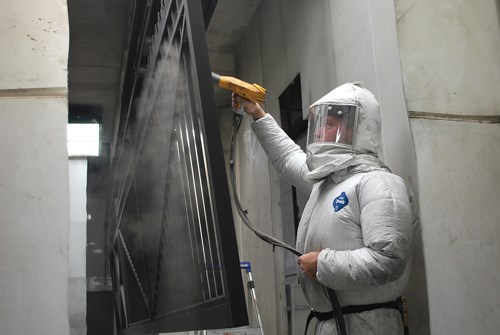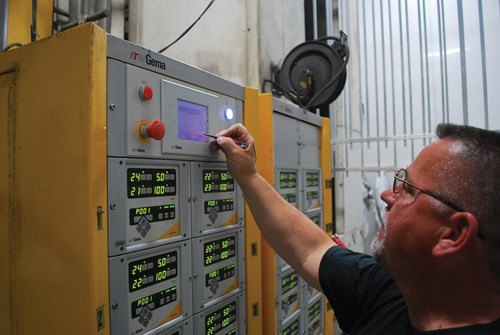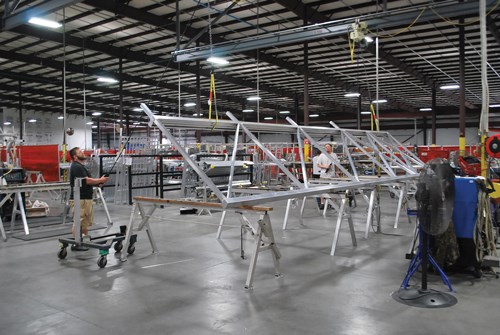Every coater has been in Chip Howison’s shoes at least once in their career … maybe even twice.
Back in 2008, he was faced with a powder-coatings-adhesion issue at the 210,000ft2 manufacturing facility he manages at Alumi-Guard in Brooksville, Fla. The problem was especially pronounced considering that Alumi-Guard—a leading manufacturer of aluminum fence and rail products—offered lifetime guarantees on its products; so the failure rate of his powder coatings had to be miniscule. Howison set out to find the solution to his problem, even if it meant taking apart his line components one-by-one.
“We just didn’t know what the problem was, so we took everything apart,” says Howison, who spent the early part of his career with General Electric in its Aerospace Division. “We looked at every single aspect of our line, from pretreatment to the powder to the equipment. Somewhere there was a problem.”
BAD TIME FOR A PROBLEM
And it couldn’t have happened at a worse time for Alumi-Guard, a privately owned company founded in 2000 by owner Bill Woodard that offers a large choice of maintenance-free, powder coated aluminum fences, gates and arbors in an array of styles, colors and heights. Business was picking up, and the company’s production and finishing lines needed to be in top shape to meet demand.
“It had to get fixed,” Howison says.
Alumi-Guard’s coating operation is complex, with two coating lines, including an automated line for parts up to 16 feet long. The company offers eight primary colors, but can meet a customers’ request for a different hue through its Custom Design Service, which provides a creative solution to the standard industry offerings.
The line issue also gave Howison and Woodard a chance to look at their entire finishing operation, and figure out just how well they could improve efficiencies, have a more reliable coating application, improve yield, reduce reject costs and study their overall powder consumption.
“Our entire operation is customer-focused,” Howison says. “We work very hard at giving customers exactly what they want and meeting their expectations. So when issues come up, we want to get on them as quickly as possible and get them resolved.”
SIX MONTHS OF FIXES
But easier said than done, as Alumi-Guard spent about six months fine-tuning operations and trying an assortment of interchanging fixes to get the issue resolved.
Howison called in various equipment distributors and sales reps, trying out several powder coating guns, tinkering with particle size, bringing in different air compressor companies, running design of experiments and testing various powder coatings.
He also called the Powder Coating Institute to get advice on what he should be doing to get optimum results from his line. This helped lead him to different PCI members and their products.
“I had some of the sharpest people in the business working with me, and I could see how everyone wanted to help me get to the root of the problem through different design trials,” Howison says. “It took some time, but we always knew that we could do better.”
One benefit for Howison was his experience at General Electric‘s Aerospace Division, which heavily emphasized a Six Sigma work environment. The strategy, which was developed by Motorola in 1986, seeks to improve the quality of process outputs by identifying and removing the causes of defects and errors, while minimizing variability in manufacturing and business processes.
SIX SIGMA APPROACH
The Six Sigma term is associated with statistical modeling of manufacturing processes, in which 99.99966 percent of the products manufactured are statistically expected to be free of defects, or the equivalent to just 3.4 defects per million parts run.
“From my GE days, I knew that getting to where we wanted to be was going to take experimentation and design tweaks of our lines and operations,” Howison says. “We looked at things from several different angles, not just the usual way. And we knew it wasn’t going to be an overnight fix.”
Having brought in some of the top guns in the powder coating industry, Howison finally settled on buying 16 ITW Gema OptiGun automatic powder guns, OptiStar control units, OptiFlow powder pumps and two ITW Gema reciprocators.
All of this was integrated with an OptiControl PC-based control system. For touch-up work in hard to coat areas, Howison added two OptiFlex manual wall units. Alumi-Guard purchased four, 200-lb hoppers for its four main colors to reduce setup time between color changes.
SETTLING ON A FIX
Howison also worked with various powder coating suppliers before settling on DuPont Coating Solutions. The partnership has gone so well that DuPont certified Alumi-Guard in October 2010 as an “Alesta Platinum Certified Architectural Applicator,” which enables Alumi-Guard to apply Alesta AR500 fluoropolymer architectural coatings on aluminum profiles and meet the American Architectural Manufacturers Association’s AAMA 2605 specification for coated aluminum extrusions and panels.
The certification process—which takes up to six months—includes passing a detailed facility audit, a review of process documentation and a quality-system review.
As a result of the powder coating system upgrade, Howison says Alumi-Guard managed to meet all of the goals he wanted:
- Achieved a more consistent and reliable coating process.
- Improved yield while reducing rejects by 25 percent.
- Reduced spare-parts usage by 87 percent.
- Reduced powder cost from 3.3 percent of sales to 2.3 percent.
“Cost and ROI were on my mind, but I knew we had to get this right,” says Howison, who also sits on the board of directors of the Manufacturers Association of Florida and the Florida Manufacturing Extension Partnership, which leverages an array of public and private resources and services that are available to manufacturers in the state.
EXPANDING SERVICES
The result also has enabled Alumi-Guard to expand on its “quick ship” program, where distributors can order between 50 and 75 fence panels and have them go out usually within a day of ordering them.
Alumi-Guard has 85 full-time employees, but expands from approximately 25 temporary workers in the off-season (winter) to almost 50 temporary workers when demand is greatest in the spring and summer months.
“We’ll do over 32,000 gates, posts, panels and 25,500 hardware parts per month in the off-season, but when we get going in the summer it can be as high as 51,000 gates, posts, panels and over 42,000 hardware parts per month,” Howison says. “We have to be flexible, and we have to be operational.”
The lesson learned from Howison’s “debugging” of his line?
“There is no quick fix,” he says. “You have to try different things to get the efficiency you want, and you always have to measure if you are making improvements. It will come, but it takes time and getting the right people together to make it happen.”
For information on Alumi-Guard, please call 877-258-6448 or visit alumi-guard.com. For information on ITW Gema, please visit itwgema.us. For information on DuPont Coating Solutions, please visit powder.dupont.com.
Axalta Coating Systems
RELATED CONTENT
-
Simply heating up the substrate does not cure the coating. There are many variables to consider when choosing the best cure oven for your application...
-
New solutions for powder coating centers combine powder preparation, conveyance, dosing and color changes into a fully automated, closed system.
-
Please explain how to calculate the heat load capacity of a paint baking oven, using aluminum alloy wheels as an example.




















